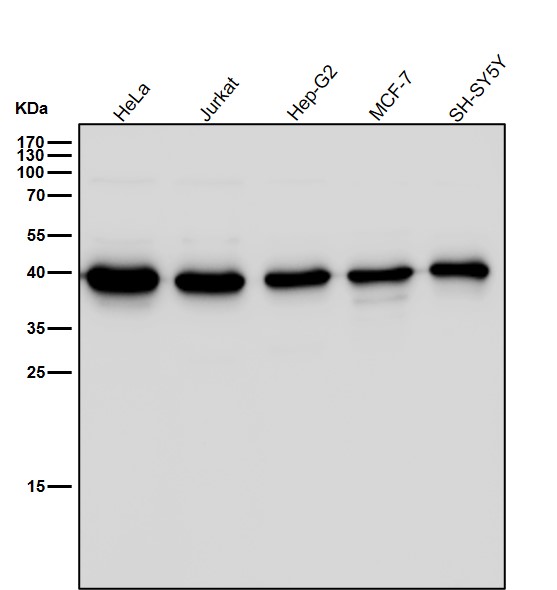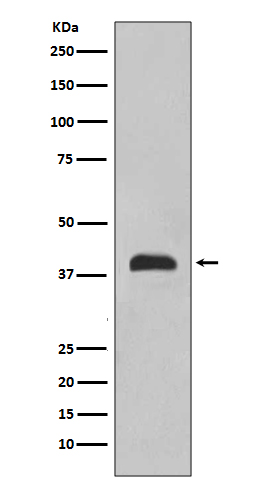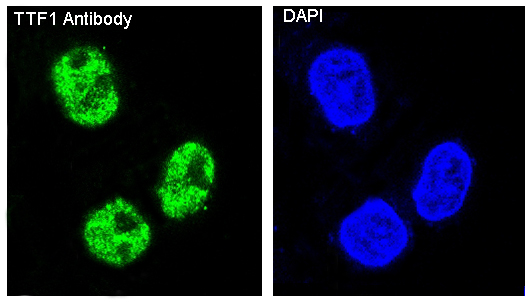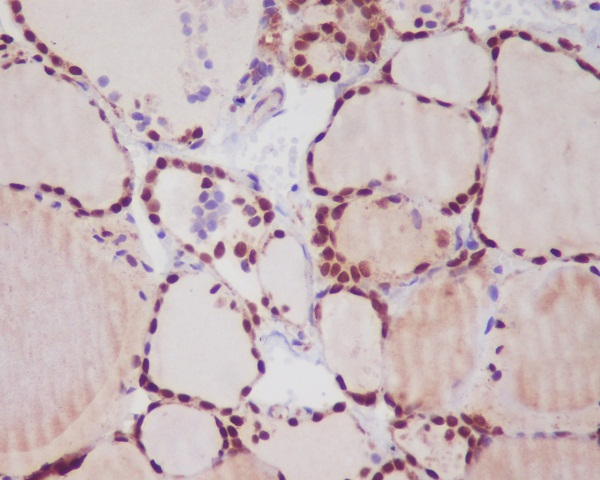




| WB | 咨询技术 | Human,Mouse,Rat |
| IF | 咨询技术 | Human,Mouse,Rat |
| IHC | IHC:1/100-1/200;IHF:1/50-1/200 | Human,Mouse,Rat |
| ICC | 1/50-1/200 | Human,Mouse,Rat |
| FCM | 1/20-1/100 | Human,Mouse,Rat |
| Elisa | 咨询技术 | Human,Mouse,Rat |
| Aliases | BCH; BHC; NK-2; TEBP; TTF1; NKX2A; TITF1; TTF-1; NKX2.1;;Nkx 2.1 |
| WB Predicted band size | 39 kDa |
| Host/Isotype | Rabbit IgG |
| Antibody Type | Primary antibody |
| Storage | Store at 4°C short term. Aliquot and store at -20°C long term. Avoid freeze/thaw cycles. |
| Species Reactivity | Human,Mouse,Rat |
| Immunogen | A synthesized peptide derived from human Nkx 2.1 |
| Formulation | Purified antibody in PBS with 0.05% sodium azide,0.05% BSA and 50% glycerol. |
+ +
以下是关于TTF1抗体的3篇代表性文献摘要:
1. **《Thyroid Transcription Factor-1 Expression in Lung Adenocarcinomas》**
- 作者:Travis WD, et al.
- 摘要:该研究分析了TTF1抗体在肺腺癌诊断中的应用,发现其高表达与肿瘤的腺癌亚型密切相关,可作为区分肺原发癌与转移癌的可靠标志物。
2. **《Utility of TTF-1 and Napsin A in the Diagnosis of Thyroid Carcinoma》**
- 作者:Jugpal TS, et al.
- 摘要:探讨TTF1与Napsin A联合检测在甲状腺癌诊断中的价值,指出TTF1对甲状腺滤泡上皮来源肿瘤的特异性,但需结合其他标志物提高准确性。
3. **《TTF-1. Surfactant Proteins, and p63 in Lung Carcinoma Typing》**
- 作者:Pelosi G, et al.
- 摘要:比较TTF1与表面活性蛋白、p63在肺癌分型中的作用,证实TTF1对肺腺癌的敏感性(约80%)及与鳞癌的鉴别意义。
4. **《TTF-1 Expression in Breast Carcinoma》**
- 作者:Reis-Filho JS, et al.
- 摘要:意外发现部分乳腺癌样本中TTF1阳性表达,提示需警惕该抗体在转移癌鉴别中的潜在交叉反应,强调结合临床背景解读结果。
*注:以上内容为文献核心结论的简化概括,实际引用需核对原文(期刊如Am J Surg Pathol, Mod Pathol等)。*
**Thyroid Transcription Factor 1 (TTF1)**, also known as NKX2-1. is a nuclear transcription factor critical in embryonic development and tissue-specific gene regulation, particularly in the thyroid, lung, and diencephalon. Discovered in the 1990s, TTF1 is a member of the NKX homeobox gene family and plays a key role in organogenesis, including thyroid morphogenesis, lung epithelial differentiation, and brain development.
In diagnostic pathology, TTF1 is widely used as an immunohistochemical (IHC) marker to determine the origin of tumors. It is highly expressed in **adenocarcinomas of the lung** (≈70-80% of cases) and **thyroid carcinomas** (e.g., papillary and follicular types), aiding in distinguishing these from other malignancies (e.g., lung squamous cell carcinoma, which is typically TTF1-negative). It also helps identify metastases of unknown primary origin.
TTF1 expression correlates with tumor differentiation and prognosis in lung cancer, where its presence may indicate better response to targeted therapies. However, aberrant TTF1 expression can occasionally occur in non-lung/non-thyroid tumors (e.g., neuroendocrine tumors), necessitating careful interpretation alongside other markers. Its role in normal and neoplastic tissues continues to be explored, particularly in molecular pathways driving carcinogenesis.
×